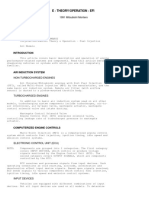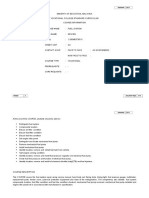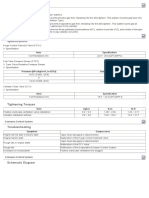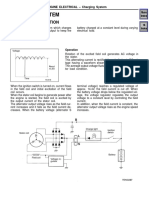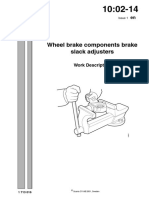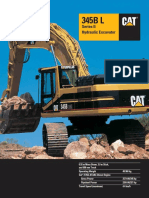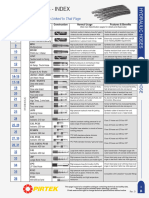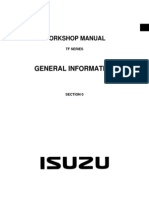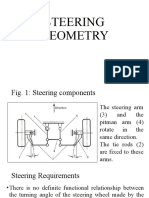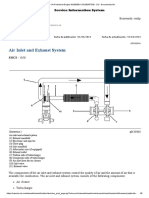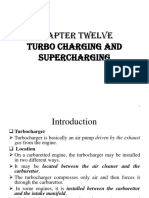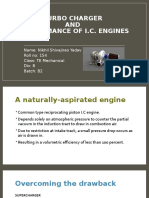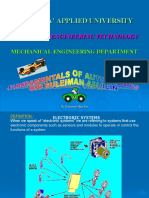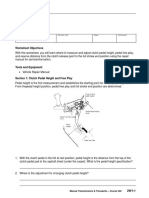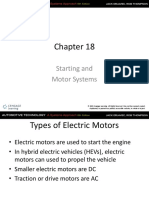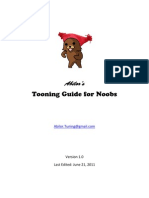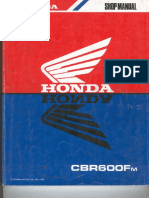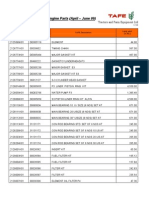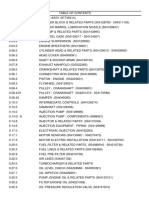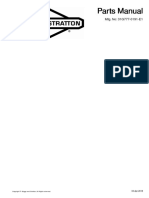Chapter 32
Intake and Exhaust Systems
2015 Cengage Learning. All Rights Reserved. May not be scanned, copied,
duplicated, or posted to a publicly accessible website, in whole or in part.
�Vacuum Systems
Vacuum in the intake draws air into the
cylinders
Also used to operate or control systems
and/or components
Vacuum is supplied by a network of hoses,
tubes, and control valves
2015 Cengage Learning. All Rights Reserved. May not be scanned, copied,
duplicated, or posted to a publicly accessible website, in whole or in part.
�Vacuum Basics
Vacuum refers to any pressure lower than
atmospheric pressure
Higher altitude = Lower pressure
Pressure at sea level is 14.7 psi
14.7 psi is usually 0 on a pressure gauge, or
0 psig
Vacuum expressed in inches of mercury (in.
Hg), kilopascals, or bars
2015 Cengage Learning. All Rights Reserved. May not be scanned, copied,
duplicated, or posted to a publicly accessible website, in whole or in part.
� Normal
atmospheric
pressure at
sea level is
about 1 bar
or 100
kilopascals
2015 Cengage Learning. All Rights Reserved. May not be scanned, copied,
duplicated, or posted to a publicly accessible website, in whole or in part.
�Engine Vacuum
It is produced by the
downward movement
of the piston on the
intake stroke
The amount depends
o the yli ders a ility
to form a vacuum and
the i takes a ility to fill
the cylinder
2015 Cengage Learning. All Rights Reserved. May not be scanned, copied,
duplicated, or posted to a publicly accessible website, in whole or in part.
�Diagnosis and Troubleshooting
Vacuum problems can produce or
contribute to the following symptoms:
Stalling
Backfiring
Poor acceleration
Overheating
Pinging
Poor fuel economy
Poor starting
Rough idle
Rich or lean stumble
Detonation or knock
Rotten egg odor
2015 Cengage Learning. All Rights Reserved. May not be scanned, copied,
duplicated, or posted to a publicly accessible website, in whole or in part.
�Diagnosis and Troubleshooting
(Cont.)
Inspect for:
Improper routing
Disconnections
Cuts
Kinks
Wear near hot spots
Damaged valves, storage devices
2015 Cengage Learning. All Rights Reserved. May not be scanned, copied,
duplicated, or posted to a publicly accessible website, in whole or in part.
�Vacuum Leaks
2015 Cengage Learning. All Rights Reserved. May not be scanned, copied,
duplicated, or posted to a publicly accessible website, in whole or in part.
�Vacuum Test Equipment
Vacuum gauge connects
to the engine
Smoke machines help
locate vacuum leaks
2015 Cengage Learning. All Rights Reserved. May not be scanned, copied,
duplicated, or posted to a publicly accessible website, in whole or in part.
� 2015 Cengage Learning. All Rights Reserved. May not be scanned, copied,
duplicated, or posted to a publicly accessible website, in whole or in part.
�Knowledge Check
Technician A says vacuum is pressure less than
atmospheric pressure. Technician B says
vacuum starts at zero atmospheric pressure.
Who is correct?
2015 Cengage Learning. All Rights Reserved. May not be scanned, copied,
duplicated, or posted to a publicly accessible website, in whole or in part.
�Air Induction System
Directs and filters outside air into the cylinders
Make sure intake ductwork is properly
installed and all connections are airtight
Air leaks after the airflow sensor will cause
driveability problems
2015 Cengage Learning. All Rights Reserved. May not be scanned, copied,
duplicated, or posted to a publicly accessible website, in whole or in part.
� 2015 Cengage Learning. All Rights Reserved. May not be scanned, copied,
duplicated, or posted to a publicly accessible website, in whole or in part.
�Air Filter/Cleaner
Primary purpose is to prevent airborne
contaminates and abrasives from entering
the cylinders
Provides filtered air for the PCV system
2015 Cengage Learning. All Rights Reserved. May not be scanned, copied,
duplicated, or posted to a publicly accessible website, in whole or in part.
� 2015 Cengage Learning. All Rights Reserved. May not be scanned, copied,
duplicated, or posted to a publicly accessible website, in whole or in part.
�Intake Manifolds
Distribute the clean air or air-fuel mixture as
evenly as possible to each cylinder
Can be classed wet or dry manifolds
Often house the thermostat and EGR
Modern manifolds are aluminum or plastic
Designs vary by engine type
2015 Cengage Learning. All Rights Reserved. May not be scanned, copied,
duplicated, or posted to a publicly accessible website, in whole or in part.
� 2015 Cengage Learning. All Rights Reserved. May not be scanned, copied,
duplicated, or posted to a publicly accessible website, in whole or in part.
�Design Variations
Runner length is designed to achieve the best
performance at particular speeds
Short runners more HP at higher speeds
Fast moving air enters intake and stops at
closed intake valve
This air then bounces around in the runner
2015 Cengage Learning. All Rights Reserved. May not be scanned, copied,
duplicated, or posted to a publicly accessible website, in whole or in part.
�Variable Intake Runners
PCM controls plenum area and/or length of
runners according to engine speed
Increases volumetric efficiency at more than
one range of engine speed
Common use is changing path of air between
short and long runners
2015 Cengage Learning. All Rights Reserved. May not be scanned, copied,
duplicated, or posted to a publicly accessible website, in whole or in part.
� 2015 Cengage Learning. All Rights Reserved. May not be scanned, copied,
duplicated, or posted to a publicly accessible website, in whole or in part.
�Servicing an Intake Manifold
Should be replaced if cracked or if sealing
surfaces are damaged
Always use new gaskets and seals
Check TSBs for updated gasket designs
Use guide bolts to ensure proper alignment
Torque fasteners to specifications and in the
correct sequence
2015 Cengage Learning. All Rights Reserved. May not be scanned, copied,
duplicated, or posted to a publicly accessible website, in whole or in part.
� 2015 Cengage Learning. All Rights Reserved. May not be scanned, copied,
duplicated, or posted to a publicly accessible website, in whole or in part.
�Intake
Manifold
Components
2015 Cengage Learning. All Rights Reserved. May not be scanned, copied,
duplicated, or posted to a publicly accessible website, in whole or in part.
�Knowledge Check
How can variable intake runners increase
performance?
2015 Cengage Learning. All Rights Reserved. May not be scanned, copied,
duplicated, or posted to a publicly accessible website, in whole or in part.
�Forced Induction Systems
Engines can not produce full power at high
speeds because the do not receive enough
air
Power output is related to the amount of air
compressed in the cylinders
More power can be produced by pressurizing
the intake mixture before the cylinder
Turbo and superchargers accomplish this
2015 Cengage Learning. All Rights Reserved. May not be scanned, copied,
duplicated, or posted to a publicly accessible website, in whole or in part.
�Intercoolers
Cools the turbocharged or supercharged air
before it reaches the cylinder
When compressed, the air gets hotter
This reduces air density and power output
Heat removal increases air density, improves
efficiency, and output
2015 Cengage Learning. All Rights Reserved. May not be scanned, copied,
duplicated, or posted to a publicly accessible website, in whole or in part.
�Intercooler
2015 Cengage Learning. All Rights Reserved. May not be scanned, copied,
duplicated, or posted to a publicly accessible website, in whole or in part.
�Turbochargers
Exhaust driven air
pumps
Exhaust gases spin the
turbine blades
The turbine turns the
compressor wheel
Air is compressed and
sent to the cylinders
Used on gas and diesel
engines
2015 Cengage Learning. All Rights Reserved. May not be scanned, copied,
duplicated, or posted to a publicly accessible website, in whole or in part.
�Turbocharger Components
Turbine (hot wheel)
Turbine shaft
Compressor (cold wheel)
Waste gate valve
Actuator
2015 Cengage Learning. All Rights Reserved. May not be scanned, copied,
duplicated, or posted to a publicly accessible website, in whole or in part.
�Typical Turbocharger System
2015 Cengage Learning. All Rights Reserved. May not be scanned, copied,
duplicated, or posted to a publicly accessible website, in whole or in part.
�Construction
The turbine spins at very high speeds
The waste gate controls the pressure of air
delivered to the cylinders
Typically begins to compress air around
2000 engine RPM
Turbo boost describes the positive pressure
10 psi of boost equals 24.7 psi
2015 Cengage Learning. All Rights Reserved. May not be scanned, copied,
duplicated, or posted to a publicly accessible website, in whole or in part.
�Turbo Lag
The lack of an immediate response
Caused by the exhaust gas requiring time to
build enough energy to spin the turbo fast
enough to respond to engine speed
2015 Cengage Learning. All Rights Reserved. May not be scanned, copied,
duplicated, or posted to a publicly accessible website, in whole or in part.
� 2015 Cengage Learning. All Rights Reserved. May not be scanned, copied,
duplicated, or posted to a publicly accessible website, in whole or in part.
�Waste Gate Valve
Excessive output pressure can cause
driveability concerns and engine damage
The waste gate allows a certain amount of
exhaust gas to bypass the turbine when boost
reaches a certain level
Can be PCM or manifold pressure controlled
2015 Cengage Learning. All Rights Reserved. May not be scanned, copied,
duplicated, or posted to a publicly accessible website, in whole or in part.
� 2015 Cengage Learning. All Rights Reserved. May not be scanned, copied,
duplicated, or posted to a publicly accessible website, in whole or in part.
�Turbo Lubrication and Cooling
The turbo must be well
lubricated and cooled
exhaust temperatures
can surpass 1800F
(982C)
Compressor wheels can
spin over 200,000 RPM
2015 Cengage Learning. All Rights Reserved. May not be scanned, copied,
duplicated, or posted to a publicly accessible website, in whole or in part.
�Various Turbocharger Designs
Variable Nozzle
Turbine
The size of the area
through which the
exhaust flows is
variable
Do not use a
wastegate
2015 Cengage Learning. All Rights Reserved. May not be scanned, copied,
duplicated, or posted to a publicly accessible website, in whole or in part.
�Various Turbocharger Designs
Twin Turbochargers
Some applications
use one for each
bank
Others use one turbo
that spins up faster
than the other,
providing more
sustained power
2015 Cengage Learning. All Rights Reserved. May not be scanned, copied,
duplicated, or posted to a publicly accessible website, in whole or in part.
�Turbocharger Inspection
Listen to sounds from the turbo system
Inspect the exhaust system for leaks
Check for intake system leaks
Waste gates may have carbon buildup
Check ignition timing, vacuum hoses, knock
sensor, and O2 sensor
2015 Cengage Learning. All Rights Reserved. May not be scanned, copied,
duplicated, or posted to a publicly accessible website, in whole or in part.
�Turbocharger Problems
Lack of Lubricant
Is commonly caused by infrequent oil changes or
using the wrong oil
Ingestion of Foreign Objects
Contamination of Lubricant
May be caused by defective seals
2015 Cengage Learning. All Rights Reserved. May not be scanned, copied,
duplicated, or posted to a publicly accessible website, in whole or in part.
� 2015 Cengage Learning. All Rights Reserved. May not be scanned, copied,
duplicated, or posted to a publicly accessible website, in whole or in part.
� 2015 Cengage Learning. All Rights Reserved. May not be scanned, copied,
duplicated, or posted to a publicly accessible website, in whole or in part.
�Replacing a Turbocharger
Plug the intake and exhaust ports and oil inlet
Put about 20cc (0.68 oz.) of oil in new unit and
turn compressor wheel several times
Ensure the engine oil is clean and full
2015 Cengage Learning. All Rights Reserved. May not be scanned, copied,
duplicated, or posted to a publicly accessible website, in whole or in part.
�Maintenance
Engine oil and filter must be maintained
Many manufacturers recommend specific
types of oil
Run the engine for at least 30 seconds after
the oil change
Ensure the air cleaner is maintained
2015 Cengage Learning. All Rights Reserved. May not be scanned, copied,
duplicated, or posted to a publicly accessible website, in whole or in part.
�Turbo Start-Up and Shutdown
Leading cause of failure is poor lubrication
If engine has not run for a day or more, start
and let idle 3 5 minutes
Never operate under load if there is less than
30 psi oil pressure
Idle the engine for 20 120 seconds before
shutdown
2015 Cengage Learning. All Rights Reserved. May not be scanned, copied,
duplicated, or posted to a publicly accessible website, in whole or in part.
�Knowledge Check
What are two ways to reduce turbo lag?
2015 Cengage Learning. All Rights Reserved. May not be scanned, copied,
duplicated, or posted to a publicly accessible website, in whole or in part.
�Superchargers
Positive displacement
air pumps driven by the
crankshaft
Improve HP and torque
by increasing air
pressure and density in
the intake
An oil cooler is typically
used
2015 Cengage Learning. All Rights Reserved. May not be scanned, copied,
duplicated, or posted to a publicly accessible website, in whole or in part.
� 2015 Cengage Learning. All Rights Reserved. May not be scanned, copied,
duplicated, or posted to a publicly accessible website, in whole or in part.
�Supercharger Operation
Air enters from a remote mounted air cleaner
and airflow meter
Once past the throttle plates, air passes
through the inlet plenum
Air is pressurized by the spinning rotors
The heated air then passes through an
intercooler
2015 Cengage Learning. All Rights Reserved. May not be scanned, copied,
duplicated, or posted to a publicly accessible website, in whole or in part.
�Air Flow
Through a
Supercharger
2015 Cengage Learning. All Rights Reserved. May not be scanned, copied,
duplicated, or posted to a publicly accessible website, in whole or in part.
�Supercharger Bypass System
May be electronically or vacuum controlled
The bypass allows the supercharger to idle
when power is not needed
With the bypass closed, boost can reach about
12 psi
2015 Cengage Learning. All Rights Reserved. May not be scanned, copied,
duplicated, or posted to a publicly accessible website, in whole or in part.
�Supercharger Bypass
2015 Cengage Learning. All Rights Reserved. May not be scanned, copied,
duplicated, or posted to a publicly accessible website, in whole or in part.
�Supercharger Designs
Roots Type
Uses a pair of three lobed rotor vanes
Belt driven via the crankshaft
G-Lader Type
Uses a scroll shaped rotor
Spins around an eccentric shaft
2015 Cengage Learning. All Rights Reserved. May not be scanned, copied,
duplicated, or posted to a publicly accessible website, in whole or in part.
� The scroll
shaped rotor
looks similar
to the scroll
mechanism
of an A/C
compressor
2015 Cengage Learning. All Rights Reserved. May not be scanned, copied,
duplicated, or posted to a publicly accessible website, in whole or in part.
�Supercharger Problems
Similar to turbocharger problems
Refer to service information for specific
symptoms and repairs
2015 Cengage Learning. All Rights Reserved. May not be scanned, copied,
duplicated, or posted to a publicly accessible website, in whole or in part.
�Maintenance
Normally superchargers have their own oil
supply
Check and correct oil level periodically
Inspect regularly for leaks
Inspect induction system for leaks and filter
condition
2015 Cengage Learning. All Rights Reserved. May not be scanned, copied,
duplicated, or posted to a publicly accessible website, in whole or in part.
�Supercharger and Turbocharger
A fe ehi les use a t i harger syste
The supercharger boosts power at low speeds
The turbo boosts power at high speeds
Used on direct injection engines
Maximum boost is around 36 psi at 1500 rpm
2015 Cengage Learning. All Rights Reserved. May not be scanned, copied,
duplicated, or posted to a publicly accessible website, in whole or in part.
�Exhaust System Components
Exhaust manifold
Exhaust pipe and
seal
Catalytic converter
Muffler
Resonator
Tailpipe
Heat shields
Clamps, brackets,
and hangers
Exhaust gas oxygen
sensors
2015 Cengage Learning. All Rights Reserved. May not be scanned, copied,
duplicated, or posted to a publicly accessible website, in whole or in part.
� 2015 Cengage Learning. All Rights Reserved. May not be scanned, copied,
duplicated, or posted to a publicly accessible website, in whole or in part.
�Exhaust Manifold
Collect and direct exhaust gases
Can be cast iron or stamped steel
Designed for particular engine/chassis
combinations
Proper tuning can create a partial vacuum that
draws the exhaust out of the cylinder
2015 Cengage Learning. All Rights Reserved. May not be scanned, copied,
duplicated, or posted to a publicly accessible website, in whole or in part.
�Exhaust Pipe and Seal
Runs between the exhaust manifold and
catalytic converter
Exhaust gaskets or seals are used to prevent
leaks between components
Most gaskets and seals need replaced if the
exhaust pipe is being replaced
2015 Cengage Learning. All Rights Reserved. May not be scanned, copied,
duplicated, or posted to a publicly accessible website, in whole or in part.
�Exhaust Pipe
2015 Cengage Learning. All Rights Reserved. May not be scanned, copied,
duplicated, or posted to a publicly accessible website, in whole or in part.
�Catalytic Converters
Located before the muffler
The extreme heat in the converter oxidizes the
exhaust
Converts undesirable exhaust gases into
harmless gases
Reduces exhaust noise
2015 Cengage Learning. All Rights Reserved. May not be scanned, copied,
duplicated, or posted to a publicly accessible website, in whole or in part.
�Catalytic Converter
2015 Cengage Learning. All Rights Reserved. May not be scanned, copied,
duplicated, or posted to a publicly accessible website, in whole or in part.
�Catalytic Converters (Cont.)
Late model vehicles use a three-way
converter (TWC)
Treats all three controlled emissions
2015 Cengage Learning. All Rights Reserved. May not be scanned, copied,
duplicated, or posted to a publicly accessible website, in whole or in part.
�Converter Problems
Can be damaged or plugged
Often caused by overheating due to raw
fuel entering the converter
A plugged converter restricts exhaust flow
Function can be checked with exhaust gas
analyzer
Use a vacuum or back pressure gauge to
check for restriction
2015 Cengage Learning. All Rights Reserved. May not be scanned, copied,
duplicated, or posted to a publicly accessible website, in whole or in part.
�Mufflers
Has baffles, chambers, tubes, or holes to
break up sound
Two common types:
Reverse flow
Straight through flow
Produces some backpressure, which affects
engine breathing
2015 Cengage Learning. All Rights Reserved. May not be scanned, copied,
duplicated, or posted to a publicly accessible website, in whole or in part.
� 2015 Cengage Learning. All Rights Reserved. May not be scanned, copied,
duplicated, or posted to a publicly accessible website, in whole or in part.
�Resonator
Acts as a second muffler or silencer
Further reduces exhaust noise
Located toward the end of the exhaust system
Looks like a small muffler
2015 Cengage Learning. All Rights Reserved. May not be scanned, copied,
duplicated, or posted to a publicly accessible website, in whole or in part.
�Tailpipe
Last pipe in the system
Releases exhaust gases beyond the backend of
the vehicle
2015 Cengage Learning. All Rights Reserved. May not be scanned, copied,
duplicated, or posted to a publicly accessible website, in whole or in part.
�Heat Shields
Protect other parts
from exhaust heat
Usually made of
pressed or
perforated sheet
metal
2015 Cengage Learning. All Rights Reserved. May not be scanned, copied,
duplicated, or posted to a publicly accessible website, in whole or in part.
�Clamps, Brackets, and Hangers
Used to properly join and support the
exhaust system
2015 Cengage Learning. All Rights Reserved. May not be scanned, copied,
duplicated, or posted to a publicly accessible website, in whole or in part.
�Knowledge Check
What are two exhaust system problems that
can affect engine performance?
2015 Cengage Learning. All Rights Reserved. May not be scanned, copied,
duplicated, or posted to a publicly accessible website, in whole or in part.
�Exhaust System Service
Any physical damage can result in partial
restriction or blockage or leaks:
Can result in loss of power and backfiring
Exhaust restriction causes increased noise and
emissions
Leaks can cause illness or death
2015 Cengage Learning. All Rights Reserved. May not be scanned, copied,
duplicated, or posted to a publicly accessible website, in whole or in part.
�Exhaust Leak
2015 Cengage Learning. All Rights Reserved. May not be scanned, copied,
duplicated, or posted to a publicly accessible website, in whole or in part.
�Exhaust System Inspection Items
Holes, road damage, and split seams
Kinks or dents
Discoloration or rust
Broken or missing hangers
Loose tailpipes or other components
Signs of catalytic converter overheating:
Bluish or brownish converter shell
2015 Cengage Learning. All Rights Reserved. May not be scanned, copied,
duplicated, or posted to a publicly accessible website, in whole or in part.
�Improper Repairs
2015 Cengage Learning. All Rights Reserved. May not be scanned, copied,
duplicated, or posted to a publicly accessible website, in whole or in part.
�Exhaust Restriction Test
Most common check is with a vacuum gauge
Connect gauge to manifold vacuum
Bring engine up to 2000 2500 RPM
Watch gauge:
Reading should stay high and steady
A falling reading indicates a restriction
2015 Cengage Learning. All Rights Reserved. May not be scanned, copied,
duplicated, or posted to a publicly accessible website, in whole or in part.
�Replacing Components
Check clearance points
Make sure new parts match the old parts
Allow the system to cool
Soak all rusted fasteners with a penetrating oil
2015 Cengage Learning. All Rights Reserved. May not be scanned, copied,
duplicated, or posted to a publicly accessible website, in whole or in part.
�Common Exhaust Tools
2015 Cengage Learning. All Rights Reserved. May not be scanned, copied,
duplicated, or posted to a publicly accessible website, in whole or in part.
�Induction Heating
Safer than using a torch
Limits heat to
component being
heated
Makes exhaust work
easier
2015 Cengage Learning. All Rights Reserved. May not be scanned, copied,
duplicated, or posted to a publicly accessible website, in whole or in part.
